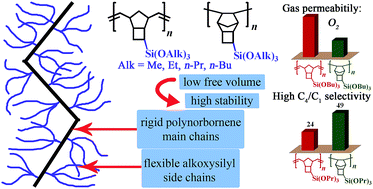Janus tricyclononene polymers bearing tri(n-alkoxy)silyl side groups for membrane gas separation†
Abstract
A series of polymers of a new type, which contain rigid polymer main chains (glassy nature) and long flexible side substituents (rubbery nature), were prepared from norbornene derivatives with (AlkO)3Si-groups of a different length (Alk = Me, Et, n-Pr, n-Bu) as promising materials for membrane separation of gaseous hydrocarbons. The 1st generation Grubbs complex and Pd–N-heterocyclic carbene complex in combination with Na+[(3,5-(CF3)2C6H3)4B]− and PCy3 were used as catalysts of metathesis and addition polymerization in the synthesis of high-molecular weight polymers (Mw ≤ 1.1 × 106) with good or high yields (up to 99%). The prepared addition polymers were glassy, while the glass transition temperature of metathesis polymers depended on the length of the alkyl-group in (AlkO)3Si-substituents and it varied in the range of −44 to 61 °C. The dramatic tuning of polymer gas-transport properties was demonstrated by the change of the polymer main chain structure and the length of tri(n-alkoxy)silyl side groups. For example, we have succeeded for the first time in obtaining metathesis polynorbornenes, which turned out to be more permeable than their addition isomers. Not being large free volume polymers, all studied metathesis and addition polytricyclononenes exhibited solubility controlled permeation of hydrocarbons (P(n-C4H10) up to 8100 barrer) and high C4/C1 selectivity (22–49).



 Please wait while we load your content...
Please wait while we load your content...